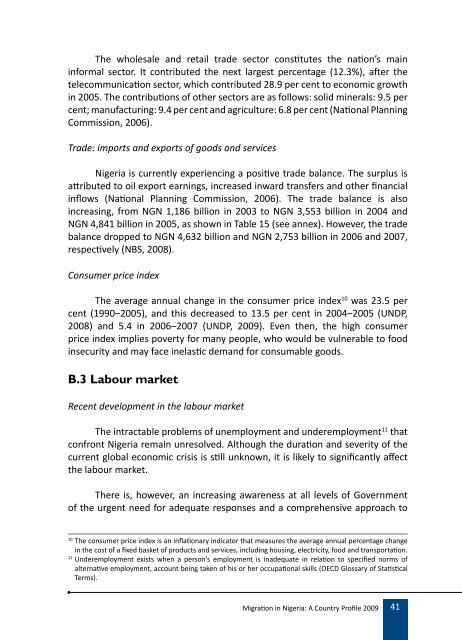Migration Profile on Nigeria - IOM Publications - International ...
Migration Profile on Nigeria - IOM Publications - International ...
Migration Profile on Nigeria - IOM Publications - International ...
Create successful ePaper yourself
Turn your PDF publications into a flip-book with our unique Google optimized e-Paper software.
The wholesale and retail trade sector c<strong>on</strong>stitutes the nati<strong>on</strong>’s main<br />
informal sector. It c<strong>on</strong>tributed the next largest percentage (12.3%), after the<br />
telecommunicati<strong>on</strong> sector, which c<strong>on</strong>tributed 28.9 per cent to ec<strong>on</strong>omic growth<br />
in 2005. The c<strong>on</strong>tributi<strong>on</strong>s of other sectors are as follows: solid minerals: 9.5 per<br />
cent; manufacturing: 9.4 per cent and agriculture: 6.8 per cent (Nati<strong>on</strong>al Planning<br />
Commissi<strong>on</strong>, 2006).<br />
Trade: imports and exports of goods and services<br />
<strong>Nigeria</strong> is currently experiencing a positive trade balance. The surplus is<br />
attributed to oil export earnings, increased inward transfers and other financial<br />
inflows (Nati<strong>on</strong>al Planning Commissi<strong>on</strong>, 2006). The trade balance is also<br />
increasing, from NGN 1,186 billi<strong>on</strong> in 2003 to NGN 3,553 billi<strong>on</strong> in 2004 and<br />
NGN 4,841 billi<strong>on</strong> in 2005, as shown in Table 15 (see annex). However, the trade<br />
balance dropped to NGN 4,632 billi<strong>on</strong> and NGN 2,753 billi<strong>on</strong> in 2006 and 2007,<br />
respectively (NBS, 2008).<br />
C<strong>on</strong>sumer price index<br />
The average annual change in the c<strong>on</strong>sumer price index 10 was 23.5 per<br />
cent (1990–2005), and this decreased to 13.5 per cent in 2004–2005 (UNDP,<br />
2008) and 5.4 in 2006–2007 (UNDP, 2009). Even then, the high c<strong>on</strong>sumer<br />
price index implies poverty for many people, who would be vulnerable to food<br />
insecurity and may face inelastic demand for c<strong>on</strong>sumable goods.<br />
b.3 labour market<br />
Recent development in the labour market<br />
The intractable problems of unemployment and underemployment 11 that<br />
c<strong>on</strong>fr<strong>on</strong>t <strong>Nigeria</strong> remain unresolved. Although the durati<strong>on</strong> and severity of the<br />
current global ec<strong>on</strong>omic crisis is still unknown, it is likely to significantly affect<br />
the labour market.<br />
There is, however, an increasing awareness at all levels of Government<br />
of the urgent need for adequate resp<strong>on</strong>ses and a comprehensive approach to<br />
10 The c<strong>on</strong>sumer price index is an inflati<strong>on</strong>ary indicator that measures the average annual percentage change<br />
in the cost of a fixed basket of products and services, including housing, electricity, food and transportati<strong>on</strong>.<br />
11 Underemployment exists when a pers<strong>on</strong>’s employment is inadequate in relati<strong>on</strong> to specified norms of<br />
alternative employment, account being taken of his or her occupati<strong>on</strong>al skills (OECD Glossary of Statistical<br />
Terms).<br />
<str<strong>on</strong>g>Migrati<strong>on</strong></str<strong>on</strong>g> in <strong>Nigeria</strong>: A Country <str<strong>on</strong>g>Profile</str<strong>on</strong>g> 2009<br />
41

















